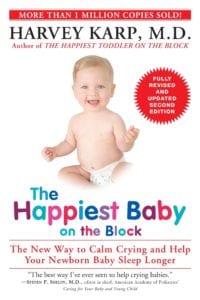Throughout your pregnancy, you always knew how many weeks along you were and which trimester you were in — right? But how much do you know about the fourth trimester?
The fourth trimester is the time period from birth until 3 months old.
This is a unique time for both mother and baby because it’s an adjustment time:
- The newborn is adjusting to life outside the womb.
- The mother is adjusting to health and wellness for herself and her new baby.
What Life Was Like For Your Baby In The Womb
The fourth trimester contains many changes for your newborn baby.
Take a minute to consider the environment inside your womb and your baby’s current environment out in the world — then compare those vast differences.
WebMD does a good job of describing what it was like for your baby inside the womb.
While in utero, your baby:
- Had all of their needs instantly met.
- Was in a soft, warm, confined space.
- Heard lots of muffled sounds. (Between the sound of your heartbeat, blood rushing through your vessels, digestion, and the sound of your voice, it’s estimated that inside your womb is louder than a vacuum cleaner!)
Fortunately, there are some things you can do to make your baby’s transition from the womb to the real world as non-disruptive as possible…
5 Ways To Re-create The Womb During The Fourth Trimester
Following are some ways that you can replicate the environment that your baby has been familiar with for the past 9 months — to make them as comfortable and happy as possible through the fourth trimester transition time. (And… as you know, a happy baby makes for an even happier mom!)
 Renowned pediatrician, Dr. Harvey Karp, is the author of The Happiest Baby on the Block. Dr. Karp encourages parents to use the 5 S’s help re-create the environment in the womb for your baby:
Renowned pediatrician, Dr. Harvey Karp, is the author of The Happiest Baby on the Block. Dr. Karp encourages parents to use the 5 S’s help re-create the environment in the womb for your baby:
#1 – Swaddling. As you are certainly aware, during your baby’s last trimester inside the womb, there wasn’t much room in there. Contrast that with the freedom of movement your baby suddenly encounters outside the womb. Proper, safe, swaddling helps your baby feel secure and calm.
#2 – Side or stomach position. When your baby is upset, placing her on her side or stomach can help quiet her. Of course, once she is asleep you will want to move her to her back.
#3 – Shushing. As noted above, babies are not used to a silent environment. The simple, repetitive noise of Shhh… Shhh…. Shhhh will soothe a baby. White noise — like a fan that’s turned on nearby (but not blowing directly on baby) or regular household noise — is comforting to a baby. There is no need to keep your house absolutely silent when your baby is sleeping!
#4 – Swinging. Babies in the womb are subject to almost constant motion. The rocking motions they feel as you go about your daily life soothes them. Try re-creating this swinging motion by wearing your baby in a sling that supports both your spine and your baby’s spine.
#5 – Sucking. Babies are born with an innate need to suck. This need starts in the womb as many babies are adorably sucking their thumbs during ultrasounds. Your baby may want to nurse often during these early weeks to meet their need for sucking.
The Bottom Line…
Skin-to-skin contact, the sound of your voice, and the smell of your skin all keep your baby happy. Keeping your baby warm and next to you also keeps them calm and soothed.
Parents do many of these things intuitively, but they may not be doing them correctly. You have to do them (the 5 S’s) exactly right, or they don’t work. For example, the swaddling must be tight, and the shushing has to be pretty loud. (Think about how a vacuum cleaner can calm a crying baby.) ~Dr. Harvey Karp
Dr. Harvey Karp was on the Dr. Phil show where he illustrated each of the 5 S’s:
Another pediatrician, Dr. Robert Hamilton has had great success at soothing babies using a specific type of hold:
Here are the 4 steps for doing “the hold” correctly.
How To Care For Yourself During The Fourth Trimester
While most of your focus is on your newborn baby during this exciting transition time, it’s important to remember that you have gone through quite the transition as well:
- Your body has worked hard to grow and nurture your baby for 9 months and deliver her into this world.
- Your hormones are changing to support breastfeeding and to assist your body in recovering from labor and delivery.
Be gentle to yourself and make sure to meet all of your own needs, in addition to the needs of your baby.
Here’s how to take better care of yourself during the fourth trimester:
#1 – Sleep. One of the most important (and often repeated) pieces of advice for new moms is to get enough rest. And it’s true… getting enough rest is essential to help your body recover while being a caring, present mother to your baby.
#2 – Nutrition. The fourth trimester is not the time to restrict calories. Your body needs optimal nutrition to heal and to produce milk for your baby. Make sure to eat a variety of foods to help fuel you. Pay attention to how your baby acts in response to the different types of foods you eat.
#3 – Help. Don’t be afraid to ask for help. Your family, friends, and even professional experts — like lactation specialists and sleep consultants — can help you and your baby during this transition.
While it has its ups and downs, ultimately the fourth trimester of pregnancy is a time of joy. The waiting is over and your baby is finally here with you.
Enjoy these magical first 3 months of your baby’s life. The fourth trimester for mom and baby is an eye-opening time of transition where you get to explore all that is new… together!
I like to help people find unique ways to do things in order to save time & money — so I write about “outside the box” ideas that most wouldn’t think of. As a lifelong dog owner, I often share my best tips for living with and training dogs. I worked in Higher Ed over 10 years before switching gears to pursue activities that I’m truly passionate about. I’ve worked at a vet, in a photo lab, and at a zoo — to name a few. I enjoy the outdoors via bicycle, motorcycle, Jeep, or RV. You can always find me at the corner of Good News & Fun Times as publisher of The Fun Times Guide (32 fun & helpful websites).








